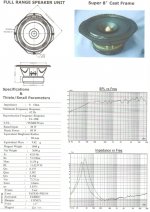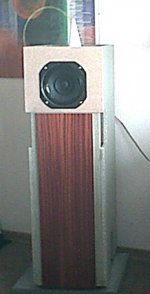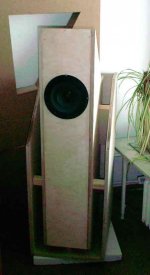Sorry to open another thread but noone seems to fit my specific needs
I have a pair of audio nirvana super8 and I would like to build a cabinet for them.
I have read that plywood is best so I think I will go for it.
Now I would like to ask which way should I go:
1. Fully enclosed cabinets (no hole)
2. Bass reflex designs (hole)
3. Folded horn design (like BIB cabinets for example)
mids and tops are just fine and will probable be fine for me at any cabinets. but bass is the issue to my decision. I like very much low end bass 25-40Hz and probably more controlled, more tight (not like "woof-woof" bass). Like the low end bass that is coming out from these sub-woofers, although these have a separate amplifier...
I would like to ask which type of cabinet should I go, and if there are any complete designs out there.
Space is not a problem unless the speaker is more than 2.5 meters tall...
Speaker specs attatched.
I have a pair of audio nirvana super8 and I would like to build a cabinet for them.
I have read that plywood is best so I think I will go for it.
Now I would like to ask which way should I go:
1. Fully enclosed cabinets (no hole)
2. Bass reflex designs (hole)
3. Folded horn design (like BIB cabinets for example)
mids and tops are just fine and will probable be fine for me at any cabinets. but bass is the issue to my decision. I like very much low end bass 25-40Hz and probably more controlled, more tight (not like "woof-woof" bass). Like the low end bass that is coming out from these sub-woofers, although these have a separate amplifier...
I would like to ask which type of cabinet should I go, and if there are any complete designs out there.
Space is not a problem unless the speaker is more than 2.5 meters tall...
Speaker specs attatched.
Attachments
Last edited:
Hello,
a solution which fit your wishes,
would be my double horns
SAXOPHON and RDH20 look on my HP
with plan, measurement and feedback
please send me a link
I'd think Super8 would play well in a 12 inch driver Karlson cabinet but would be missing the lower octave.
YouTube - "Karlsonette" 1954 twelve inch Karlson speaker with FE206EN (Zoom H2)
YouTube - "Karlsonette" 1954 twelve inch Karlson speaker with FE206EN (Zoom H2)
An externally hosted image should be here but it was not working when we last tested it.
An externally hosted image should be here but it was not working when we last tested it.
Not an ideal candidate, but not impossible.
You're asking a bit much of any nominally full range unit with that criteria. They do a lot of things well, but sub-bass is not what they're designed for and their dynamic bandwidth will not match dedicated bass units. If that's your priority, I'd be inclined to run them OB or sealed, handing over to suitable woofers below ~500Hz.
mids and tops are just fine and will probable be fine for me at any cabinets. but bass is the issue to my decision. I like very much low end bass 25-40Hz and probably more controlled, more tight (not like "woof-woof" bass). Like the low end bass that is coming out from these sub-woofers, although these have a separate amplifier...
You're asking a bit much of any nominally full range unit with that criteria. They do a lot of things well, but sub-bass is not what they're designed for and their dynamic bandwidth will not match dedicated bass units. If that's your priority, I'd be inclined to run them OB or sealed, handing over to suitable woofers below ~500Hz.
I know, they cannot outerperform these super bass subwoofers, that have been designed specifically for the bass region. I am just tryying to raise the bass as far as I can at this 25-35Hz area so the low end sound will be warmer (to my ears).
Has anyone tried these BIB (bigger is better) folded horns or would you recommend them for my needs?
Bigger Is Better 'BIB' Cabinet Dimensions - ZillaSpeak
they say "Your BIBs are designed to balance out the sound of your full/wide range driver by enhancing bass frequencies." Tuning is made by appropriate stuffing of the cabinet with fiberglass
They are much simpler to build but taller...
Has anyone tried these BIB (bigger is better) folded horns or would you recommend them for my needs?
Bigger Is Better 'BIB' Cabinet Dimensions - ZillaSpeak
they say "Your BIBs are designed to balance out the sound of your full/wide range driver by enhancing bass frequencies." Tuning is made by appropriate stuffing of the cabinet with fiberglass
They are much simpler to build but taller...
Last edited:
That's generally what vented boxes of various types are for. 
Problem is, you might raise gain in the sub-bass region, but the price is a severe restriction of dynamic bandwidth & increased potential for AMD (doppler) right up through the range. Generally, you're better off not trying to force a driver to perform outside its optimal operating window; while you may be able to do it, you'll compromise everything else in the process. Tapped horns like the BIB can give excellent results, but typically, I wouldn't try running them too low with wide-range drivers. Sub-bass duties are best handled by units designed for the task.
Problem is, you might raise gain in the sub-bass region, but the price is a severe restriction of dynamic bandwidth & increased potential for AMD (doppler) right up through the range. Generally, you're better off not trying to force a driver to perform outside its optimal operating window; while you may be able to do it, you'll compromise everything else in the process. Tapped horns like the BIB can give excellent results, but typically, I wouldn't try running them too low with wide-range drivers. Sub-bass duties are best handled by units designed for the task.
That's generally what vented boxes of various types are for.
Problem is, you might raise gain in the sub-bass region, but the price is a severe restriction of dynamic bandwidth & increased potential for AMD (doppler) right up through the range. Generally, you're better off not trying to force a driver to perform outside its optimal operating window; while you may be able to do it, you'll compromise everything else in the process. Tapped horns like the BIB can give excellent results, but typically, I wouldn't try running them too low with wide-range drivers. Sub-bass duties are best handled by units designed for the task.
It sounds to me very true, you could not expect the performance of the drivers designed specifically for the bass region. Meaning big-low-frequency-bass, I am not reffering to club music neither the "big boom" hip hop music that plays on a 300W class-D car amplifier
For example you may listen to CDs like Maria Carey musicbox, good jazz recordings and other like good quality recordings, in low volume, but with so well balance between bass mids and highs that gives you the feeling of a very good balanced speaker system which is able to produce bass at the same volume that it produces mids and highs. Low frequency bass is more pleasant to my ear than higher.
What I am trying to achieve is a bit more bass volume, to equal the high volume of mids and highs.
As you have seen in another thread I am greatly considering BIBs...
Sorry about my terminology of "big boon" etc, but I am not confident of how else can I describe the requirements in English language
In that case, assuming you do not wish to support your drivers with dedicated woofers, you're more likely to benefit from tuning slightly higher, to get more gain in the ~ 60Hz - 120Hz region, which is where most of the bass energy resides. There is rather less going on below that point; FWIW, my inclination would be to run a BIB with the appropriate Vb, but tuned to a slightly higher frequency than Fs. Terry Cain's original used a 70in box giving a ~140in horn that's 1/2 wave at 48Hz.
my super8 will get Karlson-couplers - perhaps smaller than the 3.3 cubic foot external bulk K12 which outperforms my blh (and Khorn - subjectively)
have run outta room !
this will be the smaller test cabinet for FE206EN and Super 8 and specs for two apertures
first pix from kutter
Parameters:
Gap Slope p q Area Length Wmax
0.25 1.5 3 12 83.6 18.5 12
x w
0.00 0.50
1.00 0.50
2.00 0.52
3.00 0.55
4.00 0.62
5.00 0.74
6.00 0.92
7.00 1.16
8.00 1.49
9.00 1.91
10.00 2.43
11.00 3.07
12.00 3.84
13.00 4.74
14.00 5.78
15.00 6.97
16.00 8.29
17.00 9.73
18.00 11.24
18.50 12.00
********************
Number Two
Gap Slope p q Area Length Wmax
0.5 2.9 1.08 9.5 131.9 18.5 12
Aperture
x w
0 0.50
1 0.78
2 1.10
3 1.43
4 1.76
5 2.11
6 2.46
7 2.81
8 3.17
9 3.54
10 3.91
11 4.30
12 4.72
13 5.18
14 5.73
15 6.43
16 7.38
17 8.72
18 10.69
18.5 12.00
An externally hosted image should be here but it was not working when we last tested it.
have run outta room !
this will be the smaller test cabinet for FE206EN and Super 8 and specs for two apertures
first pix from kutter
An externally hosted image should be here but it was not working when we last tested it.
An externally hosted image should be here but it was not working when we last tested it.
Parameters:
Gap Slope p q Area Length Wmax
0.25 1.5 3 12 83.6 18.5 12
x w
0.00 0.50
1.00 0.50
2.00 0.52
3.00 0.55
4.00 0.62
5.00 0.74
6.00 0.92
7.00 1.16
8.00 1.49
9.00 1.91
10.00 2.43
11.00 3.07
12.00 3.84
13.00 4.74
14.00 5.78
15.00 6.97
16.00 8.29
17.00 9.73
18.00 11.24
18.50 12.00
********************
Number Two
Gap Slope p q Area Length Wmax
0.5 2.9 1.08 9.5 131.9 18.5 12
Aperture
x w
0 0.50
1 0.78
2 1.10
3 1.43
4 1.76
5 2.11
6 2.46
7 2.81
8 3.17
9 3.54
10 3.91
11 4.30
12 4.72
13 5.18
14 5.73
15 6.43
16 7.38
17 8.72
18 10.69
18.5 12.00
Last edited:
Hmm. I think the Standard 8 in the CSA 2.8ft^3 box with twin 3in ports is a trifle misaligned, assuming the published driver specs. to be accurate.
Examples for three different vent lengths (3/4in 3in & 6in) attached, with a variation of each for voltage source amplifiers and something with a higher output impedance.
Examples for three different vent lengths (3/4in 3in & 6in) attached, with a variation of each for voltage source amplifiers and something with a higher output impedance.
Attachments
-
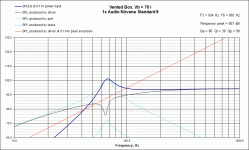 0.75in duct length low DF.gif33.5 KB · Views: 128
0.75in duct length low DF.gif33.5 KB · Views: 128 -
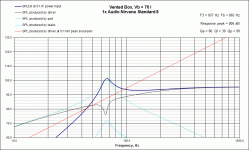 0.75in duct length voltage source.gif34.8 KB · Views: 132
0.75in duct length voltage source.gif34.8 KB · Views: 132 -
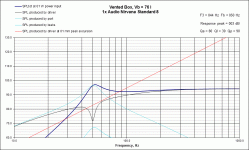 3in duct length low DF.gif34.4 KB · Views: 33
3in duct length low DF.gif34.4 KB · Views: 33 -
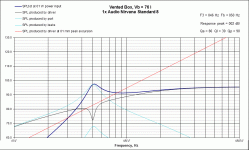 3in duct length voltage source.gif34.7 KB · Views: 35
3in duct length voltage source.gif34.7 KB · Views: 35 -
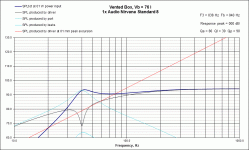 6in duct length low DF.gif33.8 KB · Views: 37
6in duct length low DF.gif33.8 KB · Views: 37 -
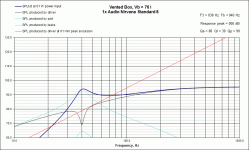 6in duct length voltage source.gif34.1 KB · Views: 38
6in duct length voltage source.gif34.1 KB · Views: 38
AN super 8's
I'll take a trifle misalignment,as compared to something with multi drivers and crossover that cost $10,000.00 and does'nt sound as good . like I said I have a superzen ,2.3watts per channel . the 2.8 with an super 8's cost $400.00 tops, 99 db sensitivity, is'nt this about maximum fidelity, minimum cost? to us...............
I'll take a trifle misalignment,as compared to something with multi drivers and crossover that cost $10,000.00 and does'nt sound as good . like I said I have a superzen ,2.3watts per channel . the 2.8 with an super 8's cost $400.00 tops, 99 db sensitivity, is'nt this about maximum fidelity, minimum cost? to us...............
It can be, but it doesn't automatically have to be. BTW, the datasheet lists as 95.4dB 1m/w rather than 99; back calculating from the published specs., that appears to be correct.
My problem with a misalignment is that by definition, it's not necessary (I was being [very] polite with the 'trifle').
My problem with a misalignment is that by definition, it's not necessary (I was being [very] polite with the 'trifle').
Last edited:
- Status
- This old topic is closed. If you want to reopen this topic, contact a moderator using the "Report Post" button.
- Home
- Loudspeakers
- Full Range
- audio nirvana super8 cabinets decision
